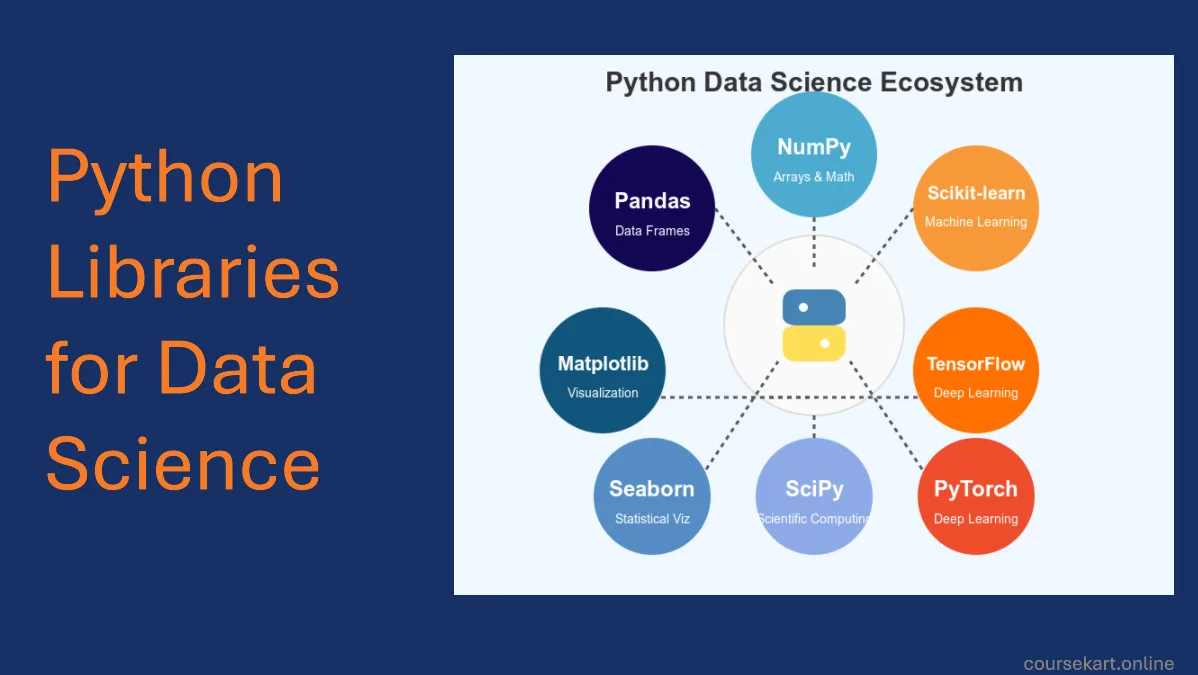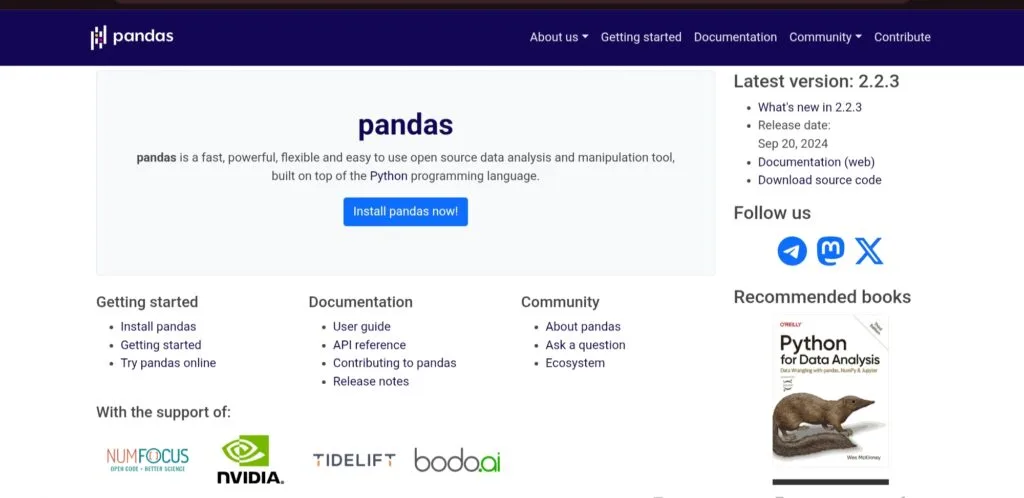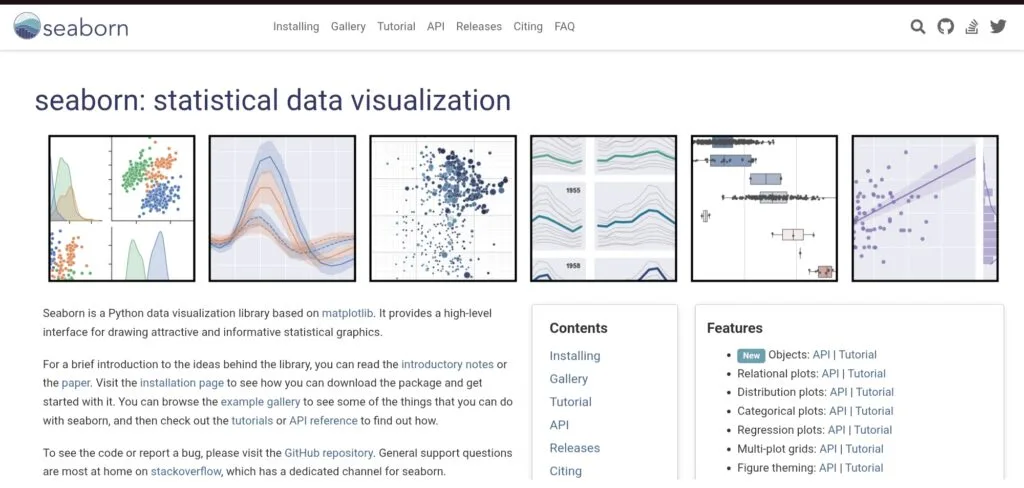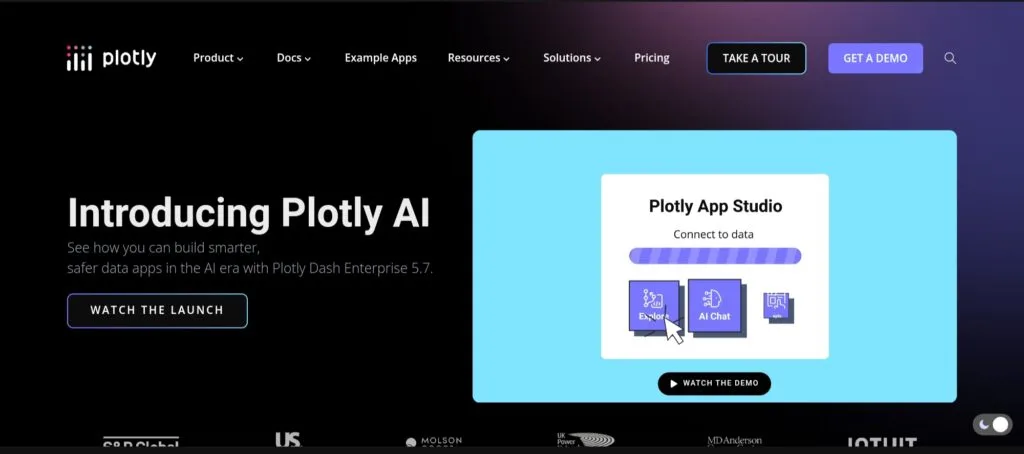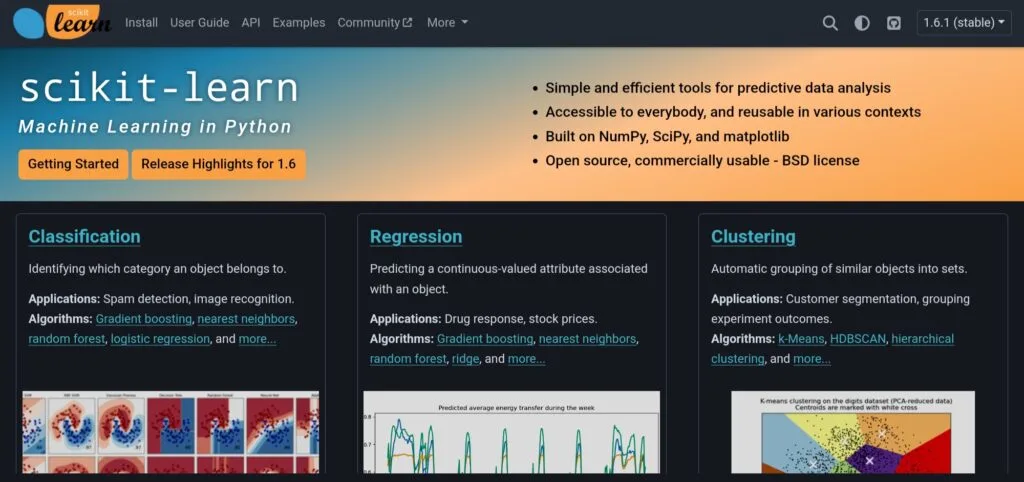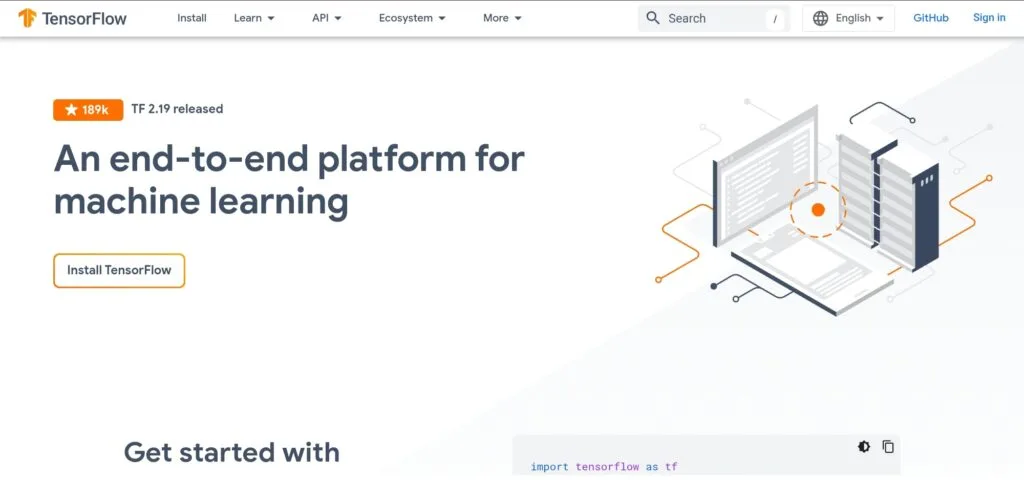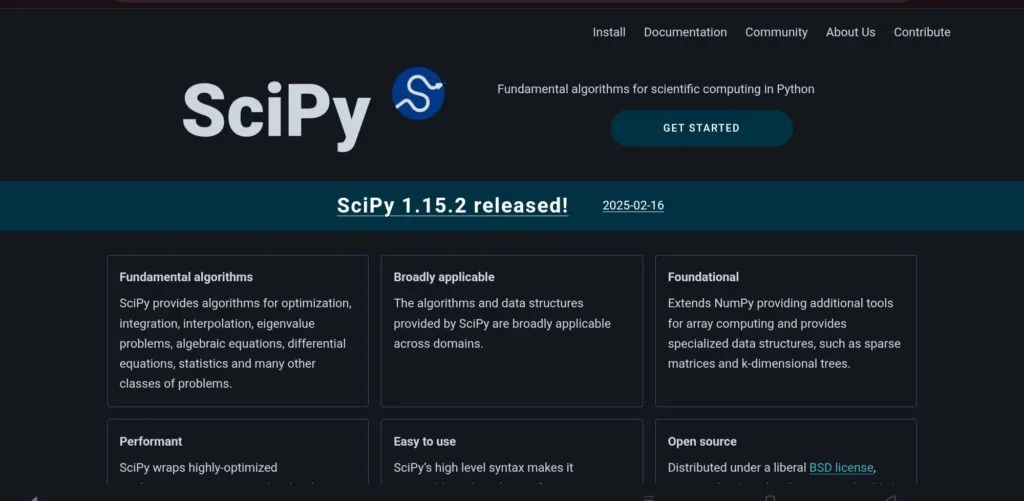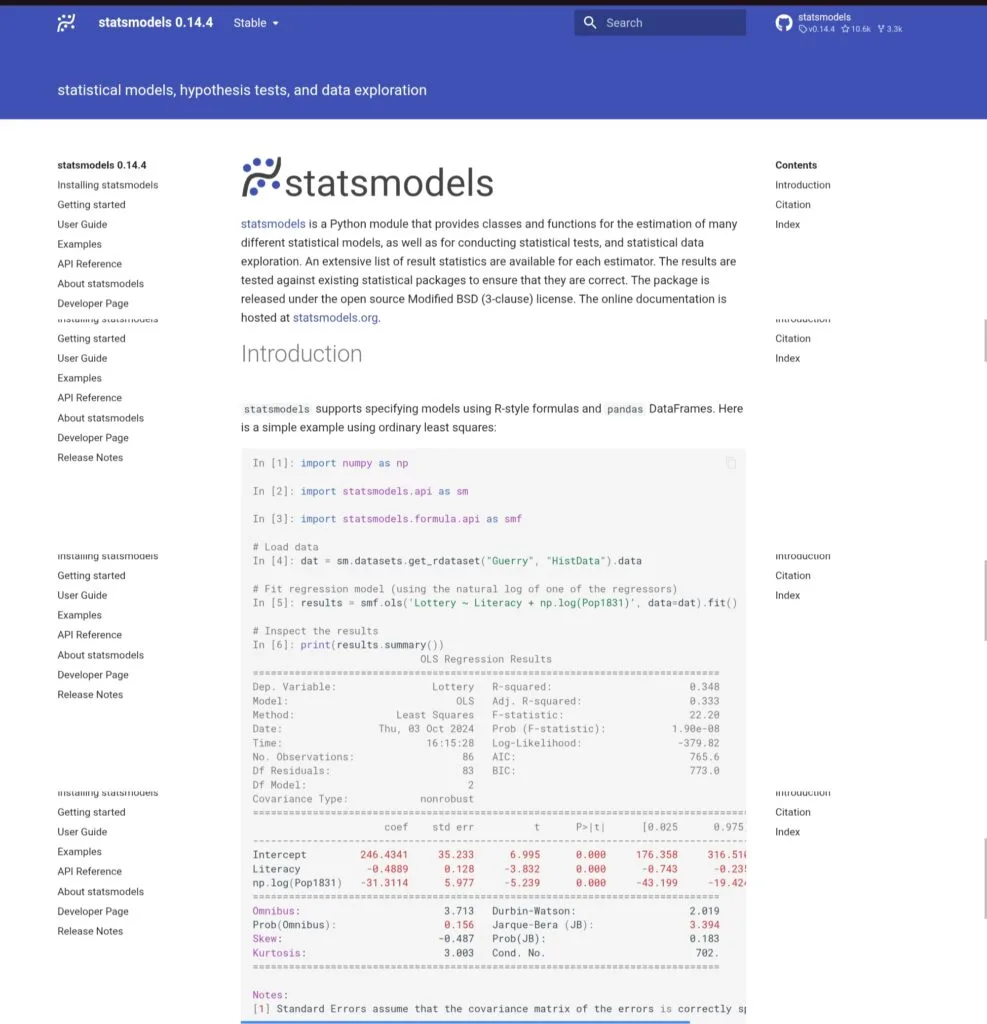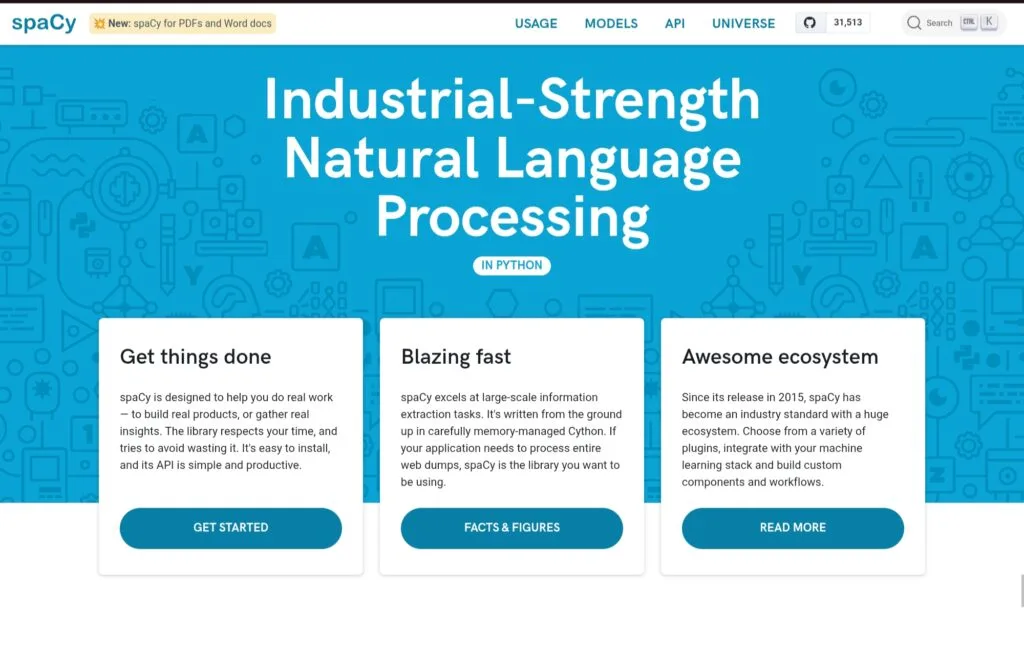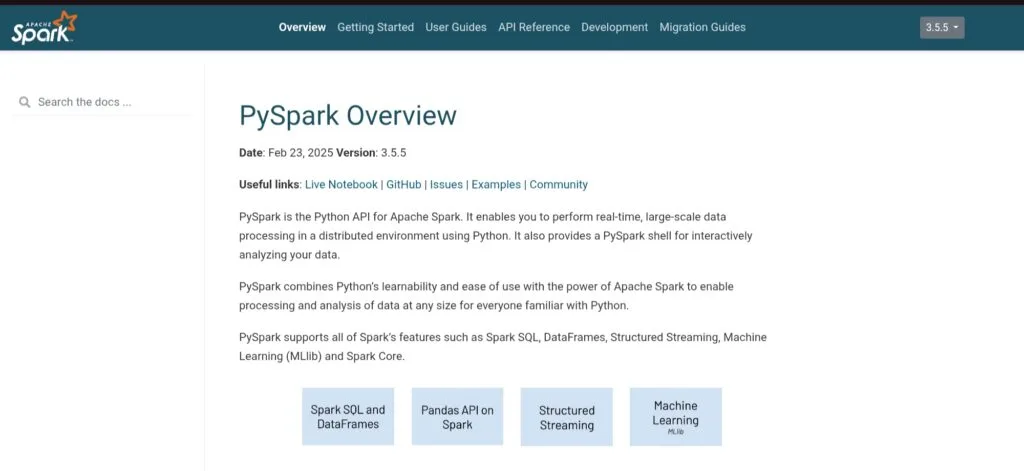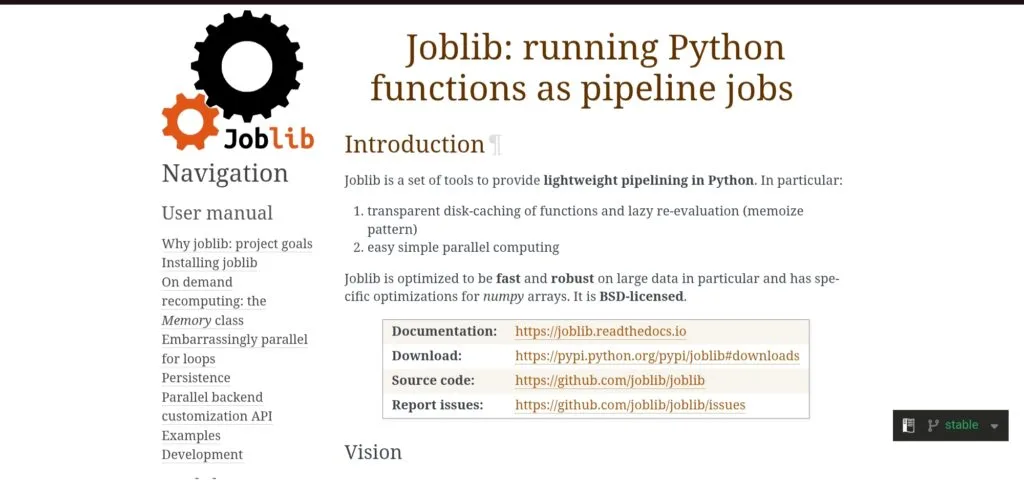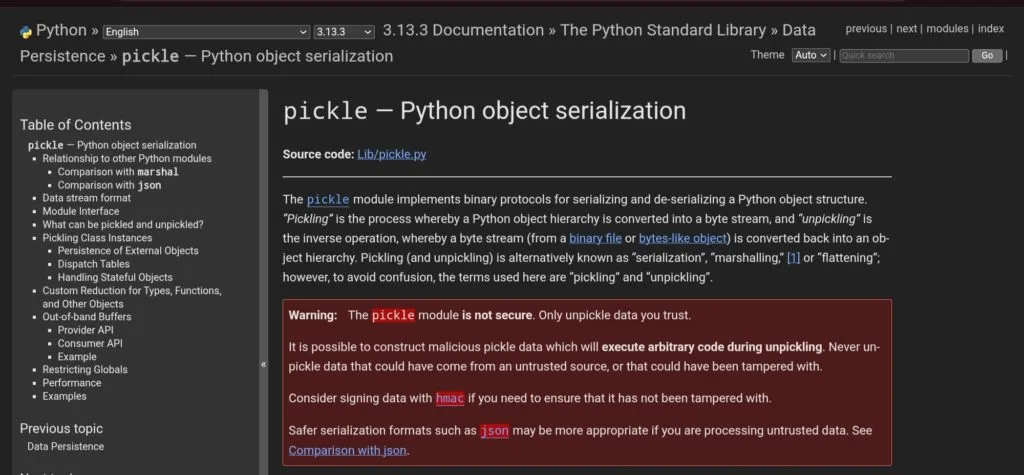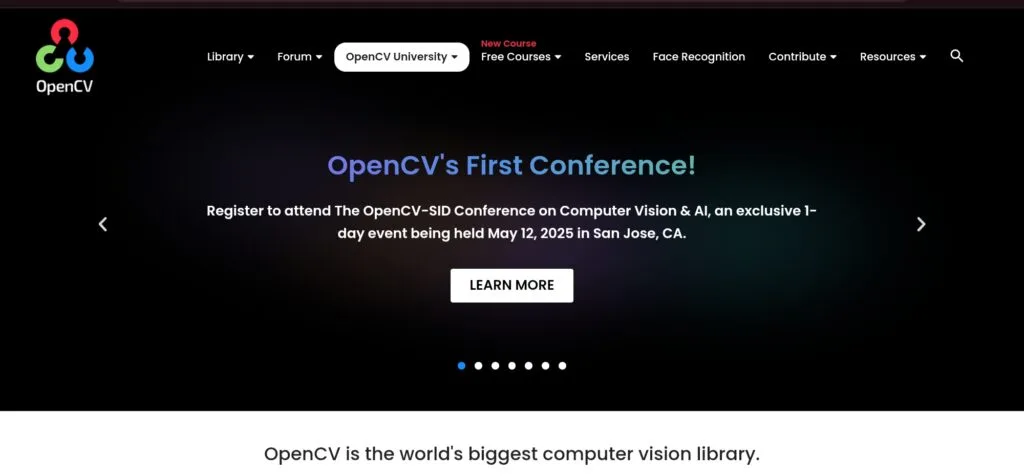With more than 66% of data professionals globally choosing Python as their primary language, it has become the clear leader in the field of data science.
This popularity isn’t a coincidence; Python’s sophisticated syntax and a robust ecosystem of specialized libraries make even the most difficult data tasks surprisingly doable.
These libraries constitute the foundation of contemporary data science workflows, not just handy shortcuts.
They allow practitioners to process gigabytes of data, develop complex Machine Learning models, and produce beautiful visualizations with astonishing efficiency by reducing what would otherwise require weeks of coding to only lines of code.
This thorough tutorial will take you through the key Python libraries for data science that will drive data science in 2025, regardless of whether you’re new to the subject, switching from another, or an experienced expert looking to add more tools to your toolkit.
Why Is Python The Preferred Language For Data Science?
Python has become the accepted language of data science for a number of strong reasons:
Simplicity and Readability
Python is understandable even by people without a lot of programming experience because of its simple syntax, which reads almost like pseudocode.
Data science has become more accessible due to the low barrier to entry, which enables domain specialists in industries such as marketing, finance, and biology to use data-driven methodologies in their work.
Strong Community and Ecosystem
Python has a thriving community that consistently adds to its growth, and it has millions of developers worldwide. This results in a wealth of tutorials, thorough documentation, and quick problem-solving via sites like Stack Overflow. Thousands of the more than 400,000 packages in the Python Package Index (PyPI) are specially made for data science applications.
Seamless Integration
Python is quite good at collaborating with others. It easily interfaces with tools such as deployment frameworks for productionizing models, SQL databases for data storage, and Jupyter notebooks for interactive computing.
Python is the perfect glue language for end-to-end data science pipelines because of its interoperability.
Categories of Python Libraries in Data Science
Understanding how Python modules for data science are organized according to functionality is helpful while navigating the wide world of them:
- Data Manipulation & Analysis: Libraries that enable efficient data loading, cleaning, transformation, and exploration – the foundation of any data science workflow.
- Data Visualization: Tools for transforming numerical insights into compelling visual narratives.
- Machine Learning & Deep Learning: Frameworks that implement algorithms to identify patterns and make predictions from data.
- Statistical Analysis: Libraries focused on hypothesis testing, parameter estimation, and statistical modeling.
- Natural Language Processing (NLP): Specialized tools for working with text data.
- Big Data & Data Engineering: Solutions for processing datasets too large for conventional methods.
- Utilities & Support Libraries: Complementary tools that enhance the data science workflow.
Core Python Libraries for Data Science
In this section, we will explore core Python libraries and their uses in data science with some examples.
Python Libraries for Data Manipulation and Analysis
1. NumPy
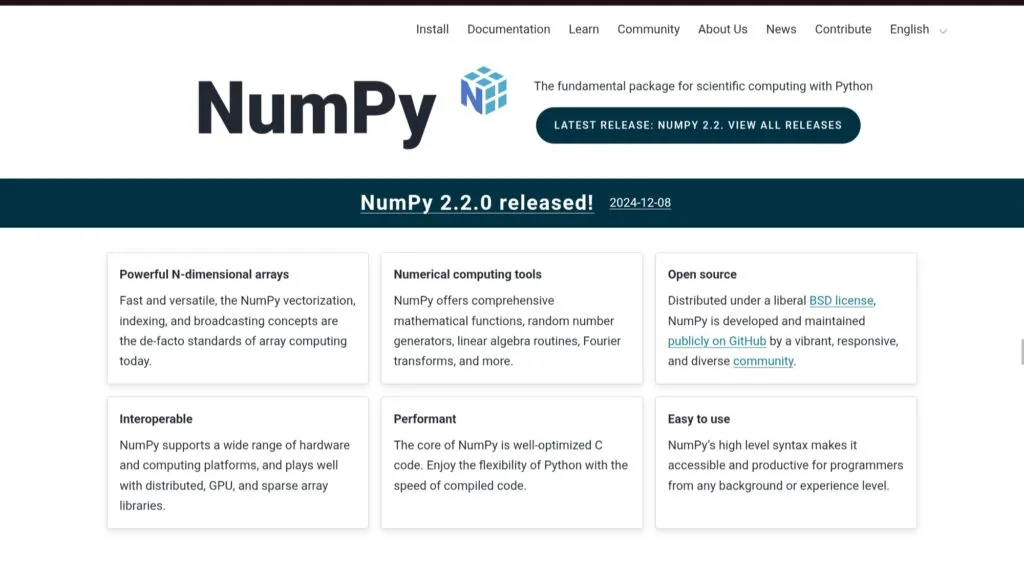
With its main data structure, the N-dimensional array object (ndarray), NumPy provides strong support for multi-dimensional arrays and matrices, making it a foundational toolkit for numerical computing in Python.
By facilitating vectorized operations, which greatly improve performance, it makes computation more efficient.
Furthermore, broadcasting features in NumPy enable operations between arrays of various shapes, streamlining intricate mathematical calculations.
The library is an effective tool for scientific and numerical analysis since it also includes built-in functions for random number generation, Fourier transforms, and linear algebra.
Use Cases
Because of its effectiveness and adaptability, NumPy is frequently used in many different fields.
It is essential to image processing because it allows for quick and efficient pixel data manipulation by expressing images as arrays.
It is crucial for scientific computing operations like mathematical modeling and simulations that require a high level of numerical precision.
Numerous potent Python libraries, such as Pandas for data analysis and Scikit-learn for machine learning, are built on top of NumPy.
It also offers the speed and capability needed for large-scale data operations, making it perfect for numerical computations that are performance-critical.
import numpy as np
# Creating and manipulating arrays
arr = np.array([1, 2, 3, 4, 5])
matrix = np.array([[1, 2, 3], [4, 5, 6]])
# Mathematical operations
print(np.mean(arr)) # 3.0
print(np.dot(matrix, matrix.T)) # Matrix multiplication2. Pandas
Pandas is a robust Python package for data analysis and manipulation that works particularly well with tabular or time-series data.
Labeled data may be efficiently stored and managed by users thanks to its fundamental data structures, DataFrame and Series.
Pandas facilitates SQL-like operations, making it simple to filter, join, and group data. It also has extensive time series analysis features and strong tools for dealing with missing values.
Pandas is essential for data wrangling activities because it offers a wide range of input/output capabilities that enable the smooth reading and writing of data from formats including CSV, Excel, and SQL databases.
Use Cases
Because of its strong data processing capabilities, Pandas is used extensively across many different disciplines.
In data cleaning and preprocessing, Pandas is essential because it enables users to convert unstructured data into a format that is ready for analysis.
Pandas works with datasets to find trends, patterns, and anomalies during exploratory data analysis (EDA).
Additionally, it is crucial for feature engineering in machine learning processes, which allows features to be created and altered to enhance model performance.
Pandas makes it easier to aggregate data and analyze time series in financial and economic studies.
It is also an effective tool for managing and analyzing vast amounts of tabular data, making it useful for social science and survey research.
import pandas as pd
# Loading and exploring data
df = pd.read_csv('data.csv')
print(df.head())
print(df.describe())
# Data manipulation
filtered_data = df[df['age'] > 30]
grouped_data = df.groupby('category').mean()
3. Dask
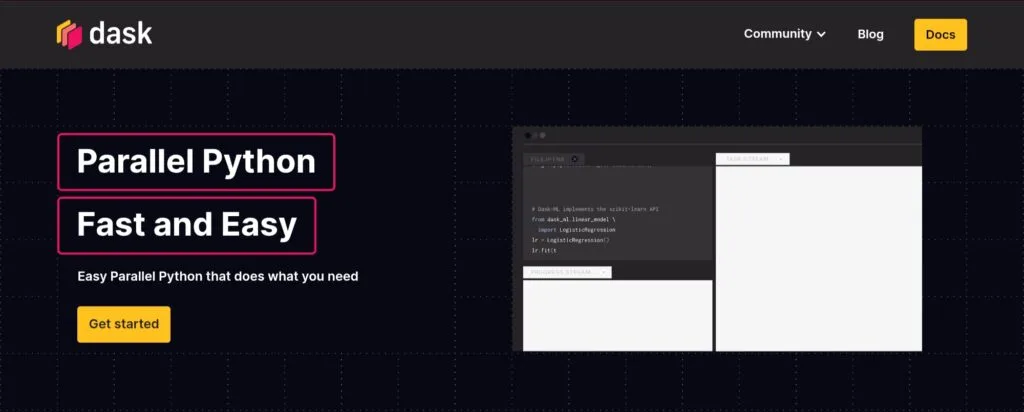
Dask is a Python library for parallel computing that was created to scale already-existing libraries for handling complicated calculations and big datasets, such as NumPy, Pandas, and Scikit-learn.
Because of its well-known API, users can effortlessly switch from ordinary Python tools to a distributed computing environment.
Task scheduling is supported by Dask to carry out processes concurrently, enhancing efficiency and performance.
Workloads can be distributed over several cores or even clusters thanks to its distributed computing features.
In order to optimize computation and resource management for big data processing, Dask also uses lazy evaluation, which postpones execution until it is absolutely required.
Use Cases
Dask is especially helpful in situations when memory or performance constraints prevent the use of more conventional tools like Pandas or NumPy.
By dividing them into smaller pieces and managing them concurrently, Dask makes it possible to handle datasets larger than a computer’s RAM in an efficient manner.
Dask greatly accelerates computationally demanding activities by utilizing multi-core CPUs for parallel processing.
It facilitates distributed computing across several computers or clusters for even more scalability.
Additionally, Dask is perfect for expanding processes that are already based on Pandas or NumPy, enabling users to work with well-known code while extending it to successfully address big data difficulties.
import dask.dataframe as dd
# Process data larger than RAM
ddf = dd.read_csv('large_file_*.csv')
result = ddf.groupby('category').value.mean().compute()
Python Libraries For Data Visualization
1. Matplotlib

For the creation of static, animated, and interactive charts, Matplotlib is the fundamental Python data visualization toolkit.
A fine-grained control over all of a figure’s components, including axes, labels, line styles, and legends, is possible thanks to its object-oriented API.
Matplotlib can be used for a variety of analytical purposes because it supports a large number of plot types, such as scatter plots, bar graphs, line charts, and histograms.
It is excellent at creating highly customizable, publication-quality figures that let users modify visuals to satisfy certain practical or aesthetic needs.
Use Cases
Matplotlib is a useful tool for both exploratory analysis and presentation because it can be used to create a wide range of visuals, whether they are static, animated, or interactive.
It is particularly preferred in scholarly and scientific settings where exact control over plot points is necessary to produce figures of publishing caliber.
Other well-known libraries, such as Seaborn and Pandas plotting routines, are supported by Matplotlib, the core library of the Python visualization ecosystem.
Additionally, it is perfect for creating highly customized visualizations because it gives precise control over every plot element to satisfy certain aesthetic or analytical needs.
import matplotlib.pyplot as plt
# Basic plotting
plt.figure(figsize=(10, 6))
plt.plot([1, 2, 3, 4], [10, 20, 25, 30], marker='o')
plt.title('Sample Data')
plt.xlabel('X-axis')
plt.ylabel('Y-axis')
plt.grid(True)
plt.show()
2. Seaborn
Seaborn is a Matplotlib-based statistical data visualization library that makes it simpler to produce eye-catching and educational visuals.
Plots’ overall appearance is improved by its appealing default styles and color schemes, which don’t require any extra setup.
With just a small amount of code, Seaborn offers a high-level interface for creating intricate statistical visualizations like pair plots, violin plots, and heatmaps.
Plotting is made easier and simpler by its dataset-oriented API, which enables users to interact directly with Pandas DataFrames.
This is especially useful for exploratory data analysis using grouped or categorical data.
Use Cases
For exploratory data analysis, when both clarity and aesthetic appeal are crucial, Seaborn is a great option.
With its user-friendly features and elegant default styles, it makes it easier to visualize statistical relationships, including regressions and correlations.
With plots like boxplots, KDE plots, and histograms, Seaborn is excellent at comparing data distributions and makes it simple to spot trends or outliers.
Deeper insights into group-wise trends can be gained by using it to visualize categorical data using bar plots, violin plots, or swarm plots.
All things considered, Seaborn makes it simple to use little code to produce engaging and educational statistics visuals.
import seaborn as sns
# Statistical visualizations
sns.set_theme(style="whitegrid")
tips = sns.load_dataset("tips")
sns.boxplot(x="day", y="total_bill", data=tips)
3. Plotly
Plotly is a robust Python package for building web-based, interactive visualizations that improve data exploration and user engagement.
It is appropriate for a variety of analytical requirements because it offers more than 40 chart kinds, such as line charts, bar graphs, heat maps, and 3D plots.
Plotly’s interactivity is one of its best qualities; users can pan, zoom, and hover over data points to see more details.
Additionally, it easily interfaces with the Dash framework, enabling programmers to create data apps and interactive dashboards.
Furthermore, Plotly provides a variety of export formats, such as HTML and JSON, which facilitates cross-platform sharing of visualizations.
Use Cases
Plotly is the best option for use cases requiring dynamic and captivating data displays.
It excels at creating interactive dashboards that let users study data in real-time, particularly when paired with the Dash framework.
Plotly works well for data storytelling as well since it lets users interact with charts by panning, zooming, or hovering to uncover more information.
Because it can output visualizations in web-friendly formats like HTML, sharing and embedding visuals through web apps is a breeze.
Plotly is a strong and adaptable solution for intricate visualizations that call for user participation, including multi-dimensional plots or real-time data updates.
import plotly.express as px
# Interactive visualization
df = px.data.gapminder()
fig = px.scatter(df, x="gdpPercap", y="lifeExp",
size="pop", color="continent",
hover_name="country", log_x=True,
animation_frame="year")
fig.show()
4. Altair
Altair is a Python package for declarative statistical visualization that is based on Vega and Vega-Lite.
By using a “grammar of graphics” approach, users may specify what they wish to see rather than how to create it, which makes the code clearer and easier to understand.
By assembling simple components, its declarative API makes it easier to create intricate plots and supports a variety of statistical visualizations.
Altair’s ability to serialize JSON makes it perfect for sharing through web technologies and embedding in web applications.
Because of its design, Altair works particularly well for quickly creating interactive, lucid, and consistent data visualizations.
Use Cases
Altair is especially well-suited for quick exploratory data analysis, allowing users to produce insightful visuals with little programming.
Because of its declarative vocabulary, it is possible to create clear, reusable visualization components that are simple to extend or modify.
Altair is perfect for integrating visualizations into interactive reports or online applications since it produces JSON-serializable specs.
It is excellent at statistical visualization jobs and provides a simple method of creating dynamic, layered, and faceted charts without the hassle of low-level plotting instructions.
import altair as alt
from vega_datasets import data
# Declarative visualization
source = data.cars()
chart = alt.Chart(source).mark_circle().encode(
x='Horsepower',
y='Miles_per_Gallon',
color='Origin',
tooltip=['Name', 'Origin', 'Horsepower', 'Miles_per_Gallon']
).interactive()
Python Libraries For Machine Learning And Deep Learning
1. Scikit-Learn
A complete Python machine learning library, Scikit-learn offers effective tools for putting traditional machine learning methods into practice.
Users may easily switch between models or adjust hyperparameters thanks to its uniform API across a variety of techniques.
In order to ensure that data is adequately prepared for modeling, Scikit-learn also comes with a number of preprocessing tools for data transformation, scaling, and cleaning.
It also offers strong tools for choosing and evaluating models, including performance indicators and cross-validation.
Scikit-learn is a great option for Python machine learning jobs since it easily interacts with well-known libraries like NumPy and Pandas.
Use Cases
Scikit-learn is widely utilized in many different disciplines for machine learning applications.
In applications like spam detection or picture recognition, where methods like logistic regression or support vector machines (SVMs) are excellent, it works well for classification tasks.
Scikit-learn can be used for regression problems such as demand forecasting or price prediction using models like decision trees or linear regression.
Additionally, it supports clustering algorithms, which makes it perfect for anomaly detection or consumer segmentation.
Furthermore, dimensionality reduction algorithms like PCA are available in Scikit-learn to help extract valuable features from big datasets.
In conclusion, it offers extensive tools for model evaluation and selection, enabling effective cross-validation and hyperparameter adjustment to guarantee optimal model performance.
from sklearn.ensemble import RandomForestClassifier
from sklearn.model_selection import train_test_split
from sklearn.metrics import accuracy_score
# Training a model
X_train, X_test, y_train, y_test = train_test_split(X, y, test_size=0.2)
model = RandomForestClassifier()
model.fit(X_train, y_train)
predictions = model.predict(X_test)
accuracy = accuracy_score(y_test, predictions)
2. XGBoost / LightGBM / CatBoost
A gradient-boosting framework with great performance, XGBoost is made to produce machine learning models that are accurate, quick, and efficient.
It is appropriate for big datasets because it offers sophisticated gradient-boosting technique implementations that maximize performance and memory efficiency.
XGBoost does not require manual encoding because it can handle categorical variables natively.
Regularization strategies are also used to avoid overfitting and guarantee that models perform properly when applied to new data.
Because of its speed, precision, and adaptability, it is frequently used to produce winning solutions in both real-world applications and machine learning contests.
Use Cases
For tasks like classification and regression, where the data is arranged in rows and columns, XGBoost is perfect since it works especially well for structured or tabular data problems.
Because of its excellent performance and capacity to manage complicated datasets well, it is frequently utilized in Kaggle contests and other data science tasks.
In order to ensure accurate predictions at scale, XGBoost is also a fantastic option for production systems that demand high accuracy and quick inference times.
It is also useful for jobs requiring model interpretability because its feature relevance aids in determining which variables have the greatest influence on the model’s decision-making process.
import xgboost as xgb
# Training a gradient boosting model
dtrain = xgb.DMatrix(X_train, label=y_train)
dtest = xgb.DMatrix(X_test, label=y_test)
params = {
'max_depth': 3,
'eta': 0.1,
'objective': 'binary:logistic',
'eval_metric': 'logloss'
}
model = xgb.train(params, dtrain, num_boost_round=100)
predictions = model.predict(dtest)
3. TensorFlow
With a primary focus on deep learning, TensorFlow is an end-to-end machine learning platform that offers a full range of tools for creating, honing, and implementing machine learning models.
Its adaptable design facilitates effective training and inference at scale by supporting computing on CPUs, GPUs, and TPUs.
TensorFlow.js enables machine learning on the web, while TensorFlow Extended (TFX) facilitates the development of production-ready machine learning pipelines.
TensorFlow Lite is perfect for developing machine learning applications in a variety of contexts, from research to actual production systems, because it also makes it possible to deploy models on mobile and edge devices.
Use Cases
TensorFlow is extensively utilized in many different fields for both production and research purposes.
It offers the adaptability and capability required to test intricate neural networks and algorithms in deep learning research.
Because of its huge collection of pre-built models and tools, TensorFlow is also widely utilized in computer vision tasks such as object identification, facial recognition, and picture categorization.
TensorFlow is the engine of Natural Language Processing (NLP) systems such as sentiment analysis, language translation, and chatbots.
It may be used to deploy machine learning models in real-world settings, such as cloud systems and mobile devices, thanks to its production capabilities and tools like TensorFlow Extended (TFX) and TensorFlow Lite.
Furthermore, TensorFlow facilitates reinforcement learning, which makes it possible to create intelligent systems that pick up knowledge by interacting with their surroundings.
import tensorflow as tf
# Building a neural network
model = tf.keras.Sequential([
tf.keras.layers.Dense(128, activation='relu', input_shape=(784,)),
tf.keras.layers.Dropout(0.2),
tf.keras.layers.Dense(10, activation='softmax')
])
model.compile(optimizer='adam',
loss='sparse_categorical_crossentropy',
metrics=['accuracy'])
model.fit(x_train, y_train, epochs=5)
4. PyTorch
Known for its dynamic computation graph, which is defined and altered in runtime, PyTorch is a deep learning platform that gives researchers and developers greater flexibility and ease of use.
Faster experimentation and simpler troubleshooting are made possible by this define-by-run method.
For machine learning professionals, PyTorch’s Pythonic programming model is approachable and easy to use because it effortlessly interacts with Python.
PyTorch offers a C++ frontend for programs that need to run quickly.
Furthermore, it facilitates distributed training, which makes it possible to scale models across several GPUs or computers.
Use Cases
PyTorch’s dynamic computation graph, which enables rapid iterations and experimentation, makes it a popular tool for deep learning research and development.
It is a widely-liked option for natural language processing (NLP) applications like sentiment analysis, machine translation, and language modeling, as well as computer vision tasks like object identification, picture segmentation, and classification.
Additionally, PyTorch is excellent at transfer learning, which allows previously trained models to be improved on fresh datasets with little training.
It is a popular framework for academic and research applications because of its adaptability and simplicity of use, which enables researchers to quickly create and evaluate innovative deep learning models.
import torch
import torch.nn as nn
import torch.optim as optim
# Defining a neural network
class Net(nn.Module):
def __init__(self):
super(Net, self).__init__()
self.fc1 = nn.Linear(784, 128)
self.fc2 = nn.Linear(128, 10)
def forward(self, x):
x = torch.relu(self.fc1(x))
x = self.fc2(x)
return x
model = Net()
criterion = nn.CrossEntropyLoss()
optimizer = optim.SGD(model.parameters(), lr=0.01)
# Training loop would follow
Python Libraries For Statistical Analysis
1. SciPy
Built on top of NumPy, SciPy is a scientific computing toolkit that offers a wealth of features for complex mathematical and scientific processes.
Users may effectively solve complex equations and systems because of its specialized modules for tasks like optimization, linear algebra, and numerical integration.
Filtering, transforming, and analyzing scientific data is made possible by SciPy’s powerful signal and image processing features.
It also offers probability distributions and statistical functions for thorough data analysis.
The library is a strong toolset for scientific and engineering applications since it also includes spatial data structures and algorithms that support tasks like computational geometry and nearest-neighbor search.
Use Cases
SciPy is frequently used in the scientific and engineering domains to accurately and efficiently solve challenging numerical problems.
It is perfect for solving optimization issues like minimizing error functions or determining the optimal parameters in mathematical models.
SciPy is useful for studying time series and audio data because it provides methods for filtering, Fourier transforms, and spectral analysis in signal processing.
Additionally, it can perform spatial computations, such as multidimensional data structures, geometric operations, and distance calculations.
Furthermore, SciPy is frequently used for statistical testing, including a variety of methods for working with probability distributions, correlation analysis, and hypothesis testing.
from scipy import stats
from scipy import optimize
# Statistical test
t_stat, p_value = stats.ttest_ind(group1, group2)
print(f"p-value: {p_value}")
# Optimization
def f(x):
return x**2 + 10*np.sin(x)
result = optimize.minimize(f, x0=0)
2. Statsmodels
Statsmodels is a Python package that focuses on hypothesis testing and statistical modeling, offering a strong basis for carrying out thorough data analysis.
It can be used to analyze correlations between variables because it provides a large variety of regression models, such as robust, logistic, and linear regression.
The library has time series analysis capabilities that allow temporal data modeling and forecasting.
A full range of statistical tests are also available from Statsmodels for comparing groups and assessing assumptions.
The library’s comprehensive output, which assists users in effectively validating assumptions and interpreting model performance, is one of its main strengths. It offers comprehensive result statistics and diagnostics.
Use Cases
Applications requiring interpretability and in-depth statistical analysis benefit greatly from the use of Statsmodels.
It is frequently employed in econometric modeling, in which researchers use methods such as time series and linear regression to examine economic links.
Statsmodels offers methods like exponential smoothing and ARIMA for time series forecasting, which are used to model and predict temporal trends.
It makes it possible to draw inferences from data using statistical inference techniques, including parameter analysis, hypothesis testing, and confidence interval estimates.
It is a useful tool for social science studies, policy evaluation, and academic research since it also facilitates causal analysis by providing models and diagnostics that aid in evaluating cause-and-effect correlations.
import statsmodels.api as sm
# Linear regression with detailed statistics
X = sm.add_constant(X) # Add intercept term
model = sm.OLS(y, X)
results = model.fit()
print(results.summary())
# Time series analysis
from statsmodels.tsa.arima.model import ARIMA
model = ARIMA(data, order=(1, 1, 1))
results = model.fit()
forecast = results.forecast(steps=5)
Python Libraries For Natural Language Processing (NLP)
1. Natural Language Toolkit (NLTK)
A complete Python package for statistical and symbolic natural language processing (NLP) is called NLTK (Natural Language Toolkit).
It offers a comprehensive collection of lexical resources, including WordNet, to aid with language comprehension and semantic analysis.
Tokenization, stemming, and lemmatization are among the fundamental text processing capabilities that NLTK offers, allowing users to quickly prepare and analyze text data.
It is appropriate for applications like part-of-speech tagging and sentence structure parsing because it also provides parsers and grammar frameworks for syntactic analysis.
NLTK is a useful tool for NLP research and education since it gives users access to a large variety of corpora and linguistic datasets.
Use Cases
For educational NLP projects and novices wishing to learn the basics of natural language processing, NLTK is perfect.
It is an excellent place to start learning how to work with human language data because of its user-friendly interface and comprehensive documentation.
Tokenization, stemming, and stopword removal are examples of text preparation activities that are frequently performed with NLTK and are crucial for getting text ready for analysis or machine learning.
By offering resources for syntactic parsing, semantic analysis, and access to annotated corpora, it also aids linguistic study.
NLTK provides an extensive and user-friendly toolkit for basic text analysis, such as named entity recognition, part-of-speech tagging, and word frequency counts.
import nltk
from nltk.tokenize import word_tokenize
from nltk.corpus import stopwords
# Text processing
text = "Natural language processing is fascinating."
tokens = word_tokenize(text)
filtered = [word for word in tokens if word not in stopwords.words('english')]
2. spaCy
An industrial-grade natural language processing (NLP) library, spaCy is made for productivity, efficiency, and speed.
Its multilingual, high-performance, pre-trained models allow for precise and quick text processing.
Among the fundamental NLP tasks that spaCy is particularly good at are named entity recognition (NER), dependency parsing, tokenization, part-of-speech (POS) tagging, and sentence segmentation.
The robust and scalable solutions offered by spaCy, which can be integrated into production workflows, are tailored for real-world applications in contrast to certain academic libraries.
It’s a great option for developers creating extensive NLP systems because of its simplified API and performance-focused approach.
Use Cases
SpaCy’s speed, scalability, and dependable performance make it a popular choice for production NLP pipelines.
For information extraction tasks like extracting names, dates, organizations, or other important elements from massive amounts of text, it works especially well.
By offering precise tokenization, sentence segmentation, and syntactic parsing—all crucial for data structuring—spaCy simplifies the processing of unstructured text in document processing.
Additionally, it does exceptionally well in named entity recognition (NER), which enables real-time entity identification and classification by systems.
Because of these features, spaCy is a great option for developing intelligent apps that need to grasp language quickly and accurately.
import spacy
# Using a pre-trained model
nlp = spacy.load("en_core_web_sm")
doc = nlp("Apple is looking at buying U.K. startup for $1 billion")
# Named entity recognition
for ent in doc.ents:
print(ent.text, ent.label_)
3. Transformers (by Hugging Face)
Hugging Face’s Transformers is a state-of-the-art NLP library that makes it simple to utilize pre-trained models like BERT, GPT, T5, and many more.
It enables users to easily modify robust language models to particular applications by fine-tuning these models on custom datasets.
Just a few lines of code are needed to complete standard NLP tasks like text classification, question answering, and summary, thanks to the library’s user-friendly pipeline API.
In order to provide accurate and efficient preprocessing, it also provides a suite of tokenizers customized for each model architecture.
Transformers is widely used in industry and academics to create sophisticated, high-performing NLP applications.
Use Cases
For many contemporary NLP tasks, the Hugging Face Transformers library works incredibly well.
It is frequently used for sentiment analysis, which aids researchers and companies in determining public opinion from social media or reviews.
It facilitates text classification by grouping emails or documents according to urgency, topic, or intent.
Models such as BERT are useful in chatbots and search engines because they can extract accurate replies from passages in question answering systems.
Another aspect is text generation; models like GPT can provide text that is both contextually appropriate and coherent for conversational agents or content development.
Finally, it supports real-time multilingual applications by enabling translation between different languages using models like MarianMT and T5.
from transformers import pipeline
# Sentiment analysis
classifier = pipeline("sentiment-analysis")
result = classifier("I've been waiting for this article on Python libraries!")
print(result) # [{'label': 'POSITIVE', 'score': 0.9998}]
# Text generation
generator = pipeline("text-generation")
text = generator("In 2025, the most important Python libraries are",
max_length=50, do_sample=True)
Python Libraries For Big Data And Data Engineering
1. PySpark
Apache Spark is a potent distributed computing platform made for large data processing and analytics, and PySpark provides the Python API for it.
Through a straightforward and recognizable Python interface, it allows users to process enormous amounts of data across numerous devices.
Massive datasets can be handled effectively thanks to PySpark’s support for distributed data operations.
In addition to effortlessly integrating with Spark’s MLlib for scalable machine learning workloads, it has an integrated SQL interface for running structured queries.
Moreover, PySpark provides tools for graph computing and supports real-time data processing via Spark Streaming, making it a flexible option for intricate data workflows in business and research settings.
Use Cases
PySpark is frequently used in situations requiring the effective processing of large amounts of data.
It’s perfect for processing large amounts of data, enabling businesses to examine datasets larger than what a single computer can store.
PySpark facilitates the large-scale extraction, transformation, and loading of data from multiple sources in ETL pipelines, frequently as a component of data engineering operations.
It is a good option for distributed machine learning because of its interaction with MLlib, which allows models to be trained on huge datasets across clusters.
By analyzing real-time data streams, PySpark facilitates real-time analytics.
Because it can query and analyze both structured and unstructured data stored across distributed storage systems like HDFS or AWS S3, it is also frequently employed in data lake analytics.
from pyspark.sql import SparkSession
from pyspark.ml.classification import RandomForestClassifier
# Creating a Spark session
spark = SparkSession.builder.appName("ML Example").getOrCreate()
# Reading data
df = spark.read.csv("hdfs://big_data.csv", header=True, inferSchema=True)
# Machine learning
rf = RandomForestClassifier(featuresCol="features", labelCol="label")
model = rf.fit(train_data)
predictions = model.transform(test_data)
2. Vaex
For working with datasets larger than the RAM on your computer, Vaex is a high-performance Python package made for out-of-core DataFrame operations.
Fast and scalable data processing is made possible by memory mapping, which effectively accesses data from disk without fully loading it into memory.
Vaex improves resource utilization by lazy computation, which means operations are only carried out when necessary.
It also has a familiar Pandas-like API that enables users to readily adapt and incorporate it into current data workflows, as well as integrated visualization capabilities for exploratory data analysis.
Data scientists who want to work efficiently and interactively with big amounts of tabular data may find Vaex very helpful.
Use Cases
With lightning-fast speed, even when working with millions or billions of rows, Vaex is especially well-suited for exploratory data analysis on huge datasets.
Because of its effective architecture, users may visualize vast volumes of data and find patterns and trends without worrying about memory constraints.
Vaex, which has a comparable API but is tailored for out-of-core processing, is also an excellent tool for moving from Pandas to big data.
This makes scaling up workflows simple for users who are already familiar with Pandas.
Vaex also facilitates interactive big data analysis, which allows for real-time charting, aggregation, and filtering of large-scale tabular data to provide quick insights.
import vaex
# Loading large dataset without memory constraints
df = vaex.open("large_file.hdf5")
# Fast statistics even with billions of rows
mean_value = df.column.mean()
histogram = df.histogram(df.column, bins=100)
Python Libraries For Utilities And Support
1. Joblib
Joblib is a small Python package that uses straightforward yet effective pipelining methods to optimize computing processes.
Transparent disk caching, which saves the results of costly function calls so they don’t need to be recalculated, is its main advantage.
Because of this, it is particularly helpful for iterative or repetitive data science projects.
Additionally, Joblib facilitates parallel computing, which greatly accelerates processing by enabling operations to be carried out concurrently across several CPU cores.
It also provides NumPy array-optimized serialization, which speeds up read/write operations and lowers overhead when working with big numerical datasets.
All things considered, Joblib is a useful tool for improving productivity and efficiency in workflows related to machine learning and scientific computing.
Use Cases
In workflows involving repetitive operations, like model training or data preprocessing, Joblib is perfect for caching the output of computationally costly functions, which can save a substantial amount of time.
It is also frequently used to execute Python functions in parallel, making use of numerous CPU cores to speed up processes like batch processing and grid searches.
Another popular use case is efficient model persistence, where Joblib’s speed and optimized handling of huge data structures make it the preferable choice over Pickle for loading and saving large NumPy arrays or machine learning models.
Joblib is a useful tool for increasing pipeline efficiency in data science and machine learning because of these capabilities.
from joblib import Memory, Parallel, delayed
# Caching function results
memory = Memory("./cache_dir", verbose=0)
@memory.cache
def expensive_function(x):
# complex computation
return result
# Parallel processing
results = Parallel(n_jobs=-1)(delayed(process_item)(item) for item in items)
2. Pickle
Python’s built-in object serialization module, Pickle, allows users to transform Python objects into byte streams and vice versa.
Because it employs a native serialization technique, a variety of Python data types are guaranteed to be compatible.
Python objects like dictionaries, lists, machine learning models, and custom classes may be saved and loaded with ease with Pickle, which makes it helpful for saving session states or intermediate results.
Both short-term caching and long-term persistence can benefit from the efficient and compact binary format it generates.
Despite not being made for optimum security or cross-language compatibility, Pickle is nonetheless a popular tool for quick and easy Python serialization operations.
Use Cases
Pickle is a popular tool for storing and loading trained machine learning models without requiring retraining.
Users can preserve program states, variables, or data structures for later use by using it to effectively persist Python objects between sessions.
In situations involving several processes where complicated objects must be shared among worker processes, Pickle also makes it easier to move items between Python processes.
It’s crucial to remember that Pickle files are not safe from harmful data and should not be utilized with unreliable sources, while being simple to use and effective for many Python-centric workflows.
import pickle
# Saving a model
with open('model.pkl', 'wb') as file:
pickle.dump(model, file)
# Loading a model
with open('model.pkl', 'rb') as file:
loaded_model = pickle.load(file)
3. OpenCV
For applications involving computer vision and image processing in Python and other languages, OpenCV (Open Source Computer Vision Library) offers a robust toolset.
In addition to reading, converting, and storing multimedia files, it offers strong image and video processing capabilities.
Face recognition, motion detection, and pedestrian tracking are just a few of the applications made possible by OpenCV’s object detection capabilities.
Its feature extraction tools assist in locating important details and patterns in pictures, which are necessary for activities like stitching and image matching.
OpenCV also has camera calibration capabilities that let developers fix lens distortion and precisely map real-world positions.
For developing robotics, augmented reality, and real-time vision systems, this library is crucial.
Use Cases
OpenCV’s speed, versatility, and wide range of features make it popular in many computer vision applications.
This popular library aids in preprocessing and enhancing photos before supplying them to machine learning models for image classification.
Real-time tracking of moving objects in films is supported by OpenCV, which is helpful for autonomous systems, robotics, and surveillance.
With its algorithms for face identification, alignment, and recognition, it’s also a well-liked facial recognition tool.
OpenCV also makes picture augmentation and filtering possible, including contrast correction, edge recognition, and noise reduction.
Because of these features, it is a mainstay in computer vision research and real-world applications in sectors including security, healthcare, and automobiles.
import cv2
# Loading and processing an image
img = cv2.imread('image.jpg')
gray = cv2.cvtColor(img, cv2.COLOR_BGR2GRAY)
edges = cv2.Canny(gray, 100, 200)
# Face detection
face_cascade = cv2.CascadeClassifier('haarcascade_frontalface_default.xml')
faces = face_cascade.detectMultiScale(gray, 1.1, 4)
How To Choose The Right Library For Your Data Science Project?
Choosing the right Python libraries for your data science project is dependent upon multiple factors:
Dataset Size And Complexity
The size and complexity of the dataset should be taken into account when selecting the appropriate data analysis tools:
- Small to Medium Datasets (fits in memory):
When working with smaller datasets that fit entirely in memory, Pandas and NumPy are excellent options. These libraries are perfect for activities like data cleansing, transformation, and statistical analysis since they enable rapid data exploration, manipulation, and analysis.
- Large Datasets (exceeds memory):
Tools such as Dask or PySpark are better suited for datasets larger than the memory capacity. You can process datasets larger than memory without needing a huge server because of Dask’s ability to manage out-of-core computations. In contrast, PySpark is made for distributed data processing, which makes it perfect for managing large datasets across computer clusters.
- Structured vs. Unstructured Data:
Pandas is the most effective tool for managing structured data, such as tables and spreadsheets, because it can handle data that is well-structured with distinct rows and columns.
Specialized libraries are needed for unstructured data, such as text and photos. Tools such as NLTK and spaCy offer strong natural language processing (NLP) capabilities for text data. OpenCV and libraries like TensorFlow or PyTorch are better equipped to handle image processing and computer vision tasks when working with images.
Type of Analysis
Depending on the type of analysis you’re doing, each library has distinct advantages in terms of tool selection.
Statistical Analysis
The best library for thorough statistical analysis is Statsmodels. It is appropriate for jobs like hypothesis testing, econometrics, and statistical modeling since it offers a large variety of statistical tests, regression models (linear, logistic, etc.), and time series analysis tools.
Machine Learning
Because Scikit-learn provides a large range of classical methods for classification, regression, clustering, and dimensionality reduction, it is perfect for traditional machine learning problems. Small to medium-sized datasets and rapid experimentation are ideal uses for it.
For tasks like structured/tabular data problems, Kaggle competitions, and production-level machine learning models where high accuracy is essential, XGBoost is an expert in gradient boosting techniques, providing optimized, high-performance implementations.
Deep Learning
PyTorch’s dynamic computational graphs, debugging easiness, and flexibility for quick prototyping make it a popular choice for deep learning research and experimentation.
TensorFlow is more designed for deep learning model deployment in production. It is perfect for scalable and production-ready solutions since it provides a complete ecosystem, which includes tools for model serving, mobile deployment (TensorFlow Lite), and browser-based machine learning (TensorFlow.js).
Natural Language Processing (NLP)
With its quick and scalable methods for tokenization, named entity recognition, part-of-speech tagging, and syntactic analysis, spaCy is a powerful toolkit for production NLP pipelines. It is designed with real-time applications in mind.
Using pre-trained models like BERT, GPT, and T5 for text categorization, sentiment analysis, translation, and other advanced natural language processing tasks is one of the many applications for Transformers by Hugging Face. Access to the most recent developments in NLP is available, and fine-tuning is supported.
Example Stacks for Common Use Cases
Tabular Data Analysis and Prediction
- Data Handling: Pandas + NumPy
- Visualization: Matplotlib + Seaborn
- Modeling: Scikit-learn + XGBoost
- Evaluation: Scikit-learn metrics
Natural Language Processing Pipeline
- Preprocessing: spaCy
- Feature Extraction: Transformers
- Modeling: PyTorch or TensorFlow
- Deployment: Flask or FastAPI
Time Series Forecasting
- Data Handling: Pandas
- Analysis: Statsmodels (ARIMA, SARIMA)
- Advanced Modeling: Prophet or Neural Networks (Keras)
- Visualization: Plotly
Big Data Processing
- Data Engineering: PySpark
- Analysis: PySpark SQL + MLlib
- Visualization: Matplotlib (for aggregated results)
- Deployment: Airflow for orchestration
Quick Comparison Table: Libraries at a Glance
| Library | Purpose | Key Strengths | Suitable Use Cases |
|---|---|---|---|
| NumPy | Numerical computing | Efficient array operations | Scientific computing, foundation for other libraries |
| Pandas | Data manipulation | Intuitive data structures | Data cleaning, exploration, feature engineering |
| Matplotlib | Visualization | Precise control | Publication-quality plots, customized visualizations |
| Seaborn | Statistical vis. | Beautiful defaults | Statistical relationships, distributions |
| Scikit-learn | Machine learning | Consistent API | Classification, regression, clustering tasks |
| TensorFlow | Deep learning | Production deployment | Computer vision, NLP, production ML systems |
| PyTorch | Deep learning | Flexibility, dynamic graphs | Research, prototyping, academic applications |
| spaCy | NLP | Speed, production-ready | Text processing, entity extraction, linguistic features |
| PySpark | Big data | Distributed computing | Data processing at scale, large ML workloads |
| Statsmodels | Statistical analysis | Comprehensive models | Econometrics, time series, statistical inference |
Resources and Tips
Recommended learning paths for beginners
- Start with Python basics (variables, functions, control flow)
- Learn NumPy and Pandas fundamentals
- Explore data visualization with Matplotlib and Seaborn
- Introduce basic machine learning concepts with Scikit-learn
- Progress to specialized domains (NLP, computer vision, time series)
Recommended learning paths for experienced programmers
- Focus on data science workflows with Pandas and NumPy
- Dive into machine learning with Scikit-learn and its ecosystem
- Specialize based on interests (deep learning, NLP, big data)
- Learn deployment and productionization tools
Resources
Books:
- “Python for Data Analysis” by Wes McKinney (Pandas creator)
- “Hands-On Machine Learning with Scikit-Learn, Keras & TensorFlow” by Aurélien Géron
- “Deep Learning with Python” by François Chollet
- “Natural Language Processing with Python” by Steven Bird, Ewan Klein, and Edward Loper
Online Courses:
- DataCamp’s “Data Scientist with Python” track
- Coursera’s “Applied Data Science with Python” specialization
- Fast.ai for deep learning
- Kaggle’s free courses on Python, pandas, and machine learning
Tutorials and Documentation:
- Official documentation for each library
- Kaggle notebooks and competitions
- Real Python tutorials
- Towards Data Science blog posts on Medium
Final Thoughts
The Python data science environment is still developing quickly, with new libraries appearing to solve certain problems and existing ones continuously getting better. Gaining technical expertise is only one aspect of mastering these tools; another is knowing which library to use for a given issue and how to integrate them into efficient data science workflows.
As you hone your abilities, keep in mind that the most useful data scientists aren’t those who are familiar with every feature in every library but rather those who can use these resources to glean insightful information and create significant solutions.
Start with the basics, such as Matplotlib, Pandas, and NumPy, and then build your toolset according to the particular issues you’re interested in resolving. Create tangible projects, give back to the community, and maintain an interest in the latest advancements in an ever-evolving profession.
For those who are eager to study, the Python data science ecosystem provides hitherto unheard-of capabilities. These libraries offer the framework for converting data into useful information, whether you’re creating recommendation systems, healthcare algorithms, or financial market analysis.
Share Now:
Related Articles
The Data Science Toolkit: 12 Most Used Data Science Tools Every Data Scientist Needs to Know
What is Data Science? A Beginner’s Guide to This Thriving Field
Discover more from coursekart.online
Subscribe to get the latest posts sent to your email.

